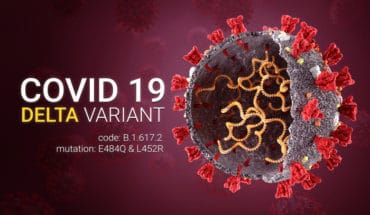COVID-19 linked with wider set of symptoms than previously thought – REACT: A study of over a million people in England has revealed additional symptoms that are linked with having the coronavirus.
In addition to the ‘classic’ symptoms – loss of sense of smell and taste, fever and new persistent cough – a wide range of other symptoms were associated with COVID-19. However, around 60% of infected people did not report any symptoms in the week leading up to their test.
Swab tests and questionnaires collected between June 2020 and January 2021 as part of the Imperial College London-led REACT study showed that among these other symptoms, chills, loss of appetite, headache and muscle aches were together most strongly linked with being infected, alongside the four classic symptoms. Having any of these other symptoms or the classic ones, either alone or in combination, was associated with infection with the coronavirus and the more symptoms people showed the more likely they were to test positive.
The study also found that there was variation in symptoms with age. While chills were linked with testing positive across all ages, headaches were reported in young people aged 5-17, appetite loss in 18-54 and 55+, and muscle aches in people aged 18-54. Infected 5-17-year-olds were also less likely to report fever, persistent cough and appetite loss compared with adults.
People in England are currently encouraged to take a COVID-19 test if they have at least one of the four classic symptoms: loss of sense of taste, loss of sense of smell, fever, new persistent cough. This is called ‘Pillar 2 testing’. Based on these new findings, the researchers estimate that current Pillar 2 testing would pick up around half of all symptomatic infections if everyone eligible were tested. But if the additional symptoms were included, this could be improved to three-quarters of symptomatic infections.
Professor Paul Elliott, director of the REACT programme at Imperial, said: “These new findings suggest many people with COVID-19 won’t be getting tested – and therefore won’t be self-isolating – because their symptoms don’t match those used in current public health guidance to help identify infected people. We understand that there is a need for clear testing criteria, and that including lots of symptoms which are commonly found in other illnesses like seasonal flu could risk people self-isolating unnecessarily. I hope that our findings on the most informative symptoms mean that the testing programme can take advantage of the most up-to-date evidence, helping to identify more infected people.”
These findings from the ongoing REal-time Assessment of Community Transmission (REACT 1) programme, led by Imperial and carried out in partnership with Ipsos MORI, are available in a pre-print report and will be submitted for peer-review. REACT is funded by the Department of Health and Social Care.
The research also explored whether the emergence of the UK’s new coronavirus variant, first identified in Kent, was linked with a different profile of symptoms.
The researchers compared self-reported symptoms and swab test results collected for the REACT study in November – December, when PHE estimated the variant made up around 16% of infections, with similar data collected in January, when an estimated 86% of infections were from the variant.
While symptoms were broadly similar, in January compared to November – December, loss or change to sense of smell was less predictive of having COVID-19, while the proportion of people testing positive with a new persistent cough appeared to be increased, in keeping with findings from ONS.
Dr Joshua Elliott, from Imperial College London’s School of Public Health, said: “As the epidemic progresses and new variants emerge, it’s essential that we keep monitoring how the virus affects people so that testing programmes meet changing needs. We hope that our data will help inform testing guidance and the development of systems which could help better identify people who should take a COVID-19 test based on their symptoms.”
About the REACT programme
The REACT-1 study is monitoring current coronavirus infections in the community by testing more than 150,000 randomly-selected people each month over a two-week period. The study recruits new people each month to help ensure the sample represents the wider population and offers a high-resolution snapshot of the situation across a particular time period. This is different from the ONS COVID-19 Infection Survey which runs continuously and samples the same people over time to understand household transmission.
People who volunteer for REACT-1 take throat and nose swabs at home, which are then analysed in a laboratory by a technique called RT-PCR. They also fill out a questionnaire detailing any symptoms they may have and providing information about social and demographic factors, such as where they work. These findings are helping guide public health measures so that the Government can better respond to the pandemic as the situation evolves.
- Gut microbiome could delay onset of type 1 diabetes - 3rd April 2025
- The da Vinci 5 Robot Is Set To Transform Bariatric Care: - 31st March 2025
- Beyond money: the hidden drivers fuelling child food insecurity - 31st March 2025






